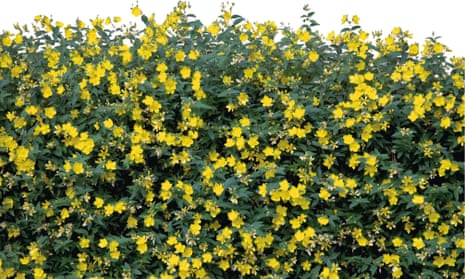All across the top field that my mother walks twice daily, the St John’s wort has turned the most wonderful autumn red: a burnished burnt umber, fat with ripening seed heads. It looked brilliant among the summer-blond grasses.
The Guardian’s product and service reviews are independent and are in no way influenced by any advertiser or commercial initiative. We will earn a commission from the retailer if you buy something through an affiliate link. Learn more.
St John’s wort (Hypericum perforatum) is so named because of its association with the knights of the Crusades and was traditionally hung around the house on St John’s Eve, in midsummer, to ward off bad spirits. It is one of a number of native hypericums. The common one, H. perforatum, is used pharmaceutically for depression and as an anti-inflammatory, and it’s a good subject for wildflower gardens. But be warned: it will self-seed shamelessly. You’ll either have to do lots of weeding or start a pharmaceutical business.
Hypericum is a big genus, and among the annuals and perennials are shrubs and trees. Piet Oudolf and Henk Gerritsen are rude about these shrubs in their book Dream Plants For The Natural Garden, writing, “We find [them] so boring and uninteresting that we just would not know what to write about them.” I understand where this comes from, but I think they may be wrong.
The genus is characterised by searing yellow single flowers borne from summer to the end of autumn. Some species finish flowering in a blaze of autumn colour and a few end in bright, berry-like fruit capsules such as H. x inodorum ‘Elstead’, whose large fruit ripen to a pretty pinkish red, often while there are still flowers appearing.
Hypericums, then, are about matching those searing yellow flowers properly, and I think the summer blond of grasses is a good way to do that, together with a palette of strong but muted reds, perhaps. You want them to be the only searing thing in a bleached-out landscape.
Rose-of-Sharon (H. calycinum) is a dwarf form often used for ground cover and works well in shade. A word of warning, though: it can be rambunctious, and will look scruffy if not given a spring haircut to remove the previous year’s growth. Do it with shears, or even a mower if you can get the blades high enough. H. x moserianum is a much more restrained choice for ground cover, and there’s the variety ‘Tricolor’, with variegated leaves in pink, white and green, plus yellow flowers, so it’s being jolly about life. Also popular is H. ‘Hidcote’, semi-evergreen with large, cup-shaped, golden-yellow flowers from late summer to autumn. Again, it benefits from a prune, otherwise its bushy, dense habit can be lost as it spreads in middle age.
All shrubby hypericums flower on this year’s growth, produced late in the season, much like buddleia. If a plant is overwhelming its space, give it a hard spring cut. This may result in later flowering, but not drastically so, and by removing plenty of leafy growth, you often get larger, showy flowers. Prune quite hard, cutting the plant to a foot off the ground if necessary, and it will still respond happily by late summer. You can also use a large shrub for an informal flowering hedge, safe in the knowledge that as long as you prune by spring, you’ll get flowers.

Comments (…)
Sign in or create your Guardian account to join the discussion